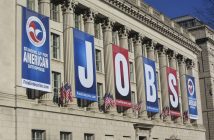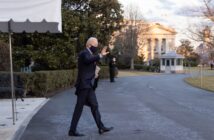When President Trump issued an executive order (EO) on April 22 to temporarily suspend the entry of some foreign workers into the United States, there were 30 million unemployed Americans. With 10 million additional jobless claims filed in the last month, there is even more justification to expand and extend the order to ensure American workers are hired first when the economy reopens.
On May 4, FAIR President Dan Stein urged the president to expand the EO to include all guestworker programs, which fall outside the scope of the order. Echoing this point in a similar letter sent three days later, a group of Republican senators noting that “it defies common sense to admit additional foreign guest workers to compete for such limited employment” and encouraged the president to limit any exemptions to “time-sensitive” industries, and only when a company can certify they were unable to find Americans for open positions.
Are these just these demands of so-called “hardline” immigration opponents? If so, then the 69 percent of Americans who support pausing immigration, according to a late April Washington Post poll, are hardliners too. Unfortunately, lawmakers, corporate America and mass immigration groups have been ignoring the judgment of those whose interests they claim to represent for decades
While a report from Politico that a broadening of the EO is possibly going to be announced this week, there is justifiable concern that pro-business factions within the Trump administration will water down needed revisions. Simply consider that since the EO was signed, officials at the Department of Homeland Security (DHS) petitioned a court not to revoke the rights of the spouses of H-1B visa holders to work in the United States,
Even if executive order is amended, it would only be temporary and does not fix the existing loopholes and incentives for fraud that have plagued foreign worker programs for years. It would be cause for rejoicing that last week a bipartisan, bicameral group of lawmakers introduced a bill to close loopholes in the H-1B and L-1 visa programs, were it not the latest in a long line of efforts to achieve real reform.
Two of the sponsors, Sens. Chuck Grassley (R-Iowa) and Dick Durbin (D-Ill.), have been lobbying for change for years. Their first legislation was introduced in 2007 and was defeated by special interest groups. In 2011, the Government Accountability Office (GAO) issued a report which warned that existing problems in the H-1B program remained unaddressed, that statutory changes made to it had actually increased the pool of H-1B workers beyond the cap and that the bar for eligibility actually had been lowered. In 2015, Durbin and Grassley tried again and were defeated again.
In their May 7 letter to President Trump, the senators also call for an end to the Optional Practical Training (OPT) program, which allows foreign nationals to retain their student visas after graduation for the purposes of working, not studying, in the U.S.
The multiple downsides of OPT have been documented. The Economic Policy Institute noted in 2015, it not only poses risks to American workers, but “will further reduce employment opportunities for U.S. graduates in STEM fields.”
As the Class of 2020 graduates and heads into the worst job market since the Great Depression saddled with debt, and as record gains in minority employment are wiped away, it would seem that the majority of Americans who support pausing immigration have the right idea.




